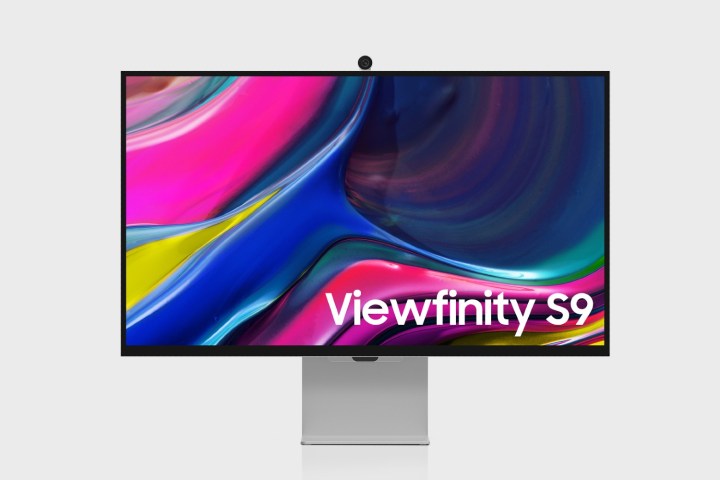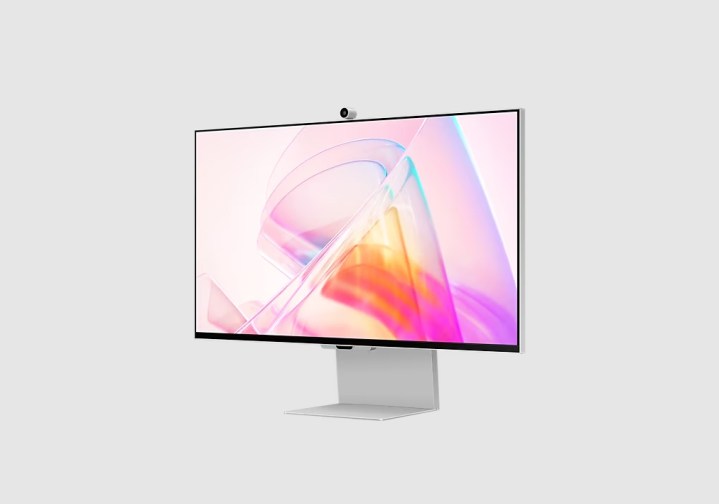
Samsung showcased the ViewFinity S9 studio monitor in January at CES 2023. Several months later, we finally have official pricing and availability details. According to Samsung, customers will be able to purchase it starting in August at a starting price of $1,599.
Judging by the price and features, it is pretty evident that Samsung has made a direct competitor to the Apple Studio Display. You get a similar 27-inch panel with a 5K resolution along with impressive color reproduction capabilities. Even the design language and port selection are seemingly inspired by Apple’s professional studio monitor.
Let’s have a look and compare the two premium monitors to see which one is better for the asking price.
Specs
| Samsung ViewFinity S9 | Apple Studio Display | |
| Screen Size | 27-inches | 27-inches |
| Resolution | 5120 x 2880 pixels, 218 pixels per inch | 5120 x 2880 pixels, 218 pixels per inch |
| Panel Type | IPS | IPS |
| Brightness | 600 nits | 600 nits |
| Color Gamut | DCI-P3 99% | Wide color P3 |
| Camera | Detachable, 4K (3,840 x 2,160) | Built-in, 12MP wide-angle with f/2.4 |
| Speakers | 5W stereo speakers with Adaptive Sound+ | High-fidelity six-speaker system with support for Spatial Audio and Dolby Atmos |
| Ports | 1x Thunderbolt 4, 3x USB-C, 1x Mini-DisplayPort | 1x Thunderbolt 3, 3x USB-C |
| Wireless connectivity | Wi-Fi 5, Bluetooth 4.2, AirPlay | NA |
| Price | $1,599 | $1,599, $1,899 (nano-textured glass) |
As you can see, most of the core features are very similar to the Apple Studio Display. However, the ViewFinity S9 offers an additional video port (Mini DisplayPort), a higher resolution webcam, and a matte panel which costs an extra $300 if you go for the Studio Display.
There’s also support for Wi-Fi 5, Bluetooth 4.2, and AirPlay so you can seamlessly use the display with compatible Apple products.
Design
Samsung’s ViewFinity S9 looks strikingly similar to the Apple Studio Display featuring a slim industrial design with a light grey finish. In terms of thickness, the ViewFinity measures 17mm while the Studio Display comes in at 19mm. The ViewFinity S9 also offers a better screen-to-body ratio with 7mm bezels on the top and sides and 13mm at the bottom. The Apple Studio display, on the other hand, offers uniform bezels that are 13mm in thickness.

Apple managed to have a built-in power supply, so you don’t need to make space for a power brick, unlike the ViewFinity S9 monitor that comes with an external adaptor.
Samsung also bundles a tilt- and height-adjustable stand with additional support for VESA mounting in case you don’t want to use the desk stand. In contrast, Apple gives you the option to buy the Studio Display with a standard stand, an adjustable stand, or a VESA mount, each sold separately at an additional cost.
Lastly, the Studio Display features a built-in 12MP webcam with support for Center Stage, while Samsung’s offering comes with a detachable 4K camera that simply snaps onto the top.
Image quality

While we haven’t tested the monitors side by side, it is expected that both offer excellent image quality. Both monitors come with an IPS panel but the ViewFinity S9 features a matte finish, which means it should be able to handle glare much better than the Studio Display which comes with a glossy finish as standard. You can go for the Nano-texture glass on the Studio Display but that costs an extra $300. It is important to note that having a matte display can potentially reduce brightness and overall contrast and color vibrancy.
Speaking of vibrancy, the ViewFinity S9 and the Studio Display both claim to offer an impressive 600 nits of brightness, which should be plenty bright for most users. There is also support for 10-bit color and DCI-P3 gamut, while the Samsung monitor additionally provides support for HDR600, which Apple does not. In either case, because these are IPS panels, so don’t expect the stellar HDR performance that you’ll get in OLED or mini-LED displays.
Ports

The Samsung ViewFinity S9 comes with a Thunderbolt 4 port, three USB Type-C ports, and a mini DisplayPort. It also comes with a control joystick to adjust settings. Apple’s Studio Display, however, is limited in terms of port selection as you get a single Thunderbolt 3 port and three USB Type-C ports. Clearly, Samsung has the upper hand here as one can connect two devices at the same time and switch between them. Notably, both monitors support power delivery of up to 90W via their respective Thunderbolt ports.
Additional features
As mentioned earlier, the Samsung ViewFinity S9 is loaded with a bunch of extra features. You get 5W stereo speakers, multiview (split screen), and support for Samsung DeX. There is also support for wireless connectivity. This allows you to connect the monitor to speakers, keyboards, game controllers, and other peripherals using Bluetooth or drop content from compatible Apple devices using AirPlay.
There’s also built-in Wi-Fi and Tizen TV OS baked into the monitor, thus giving you access to a variety of apps including video streaming services like YouTube, Netflix, Disney+, and more. Using the bundled remote, one also gets better access to controls and settings.
The Apple Studio Display comes with the company’s A13 Bionic chipset bringing support for Center Stage and “Hey Siri.” The monitor also comes with a six-speaker setup that supports Spatial Audio. The only user settings that you can access are via the operating system that allows you to adjust brightness and volume control.
Which one to choose?

For its price, the ViewFinity S9 looks to offer a much better value compared to the Apple Studio Display. If you care about wider compatibility with devices, wireless connectivity, and better access to settings, then the Samsung ViewFinity S9 should be your pick. It even doubles as a smart TV thanks to Tizen TV OS.
Having said that, image quality is something that requires thorough real-world testing and hopefully, so we can’t make a final determination until we’ve tested both monitors side by side. At the very least, though, it seems like the ViewFinity S9 might have what it takes to rival the Apple Studio Display.




